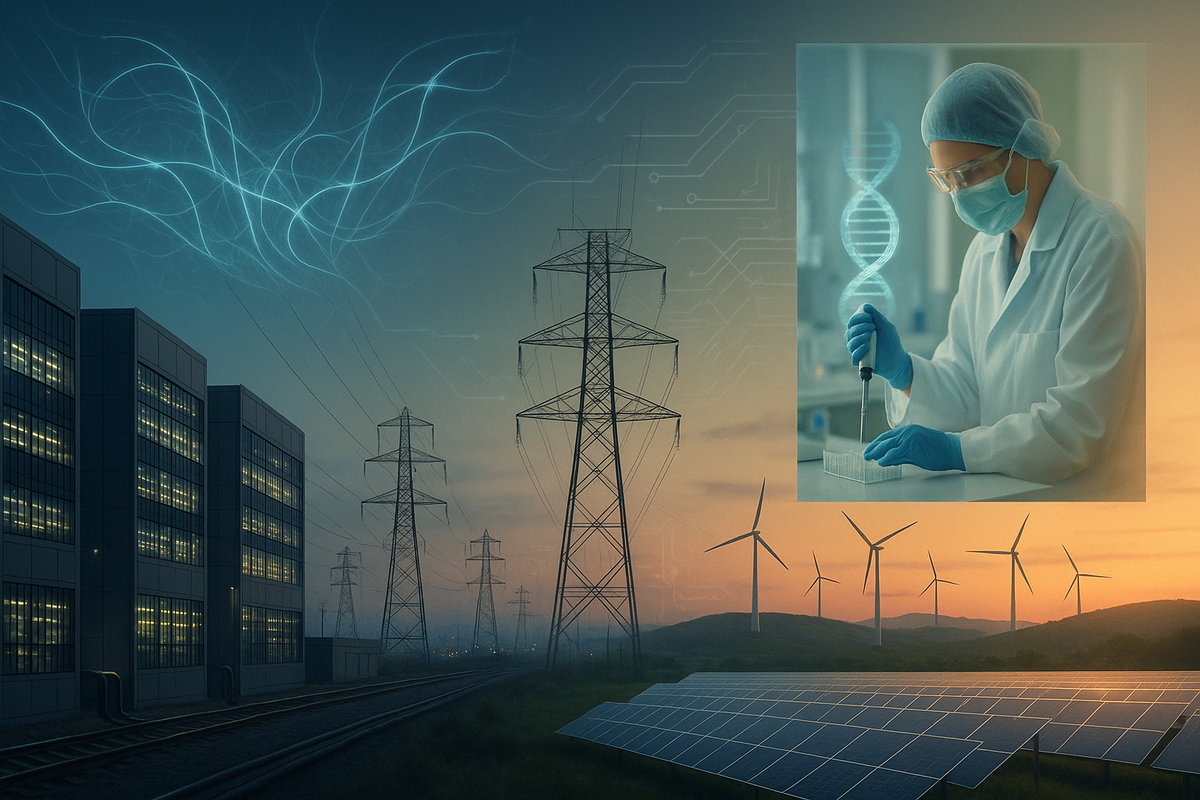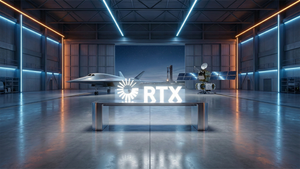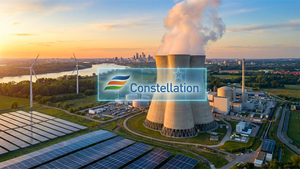
The global economy in 2025 is navigating a landscape profoundly reshaped by the escalating demands of Artificial Intelligence (AI) and transformative shifts in healthcare. While the burgeoning energy consumption of AI data centers is putting unprecedented strain on power grids and catalyzing a new wave of investment across traditional and renewable sources, the biotechnology sector stands at the precipice of a new era of innovation, driven by breakthroughs in gene editing and personalized medicine. Simultaneously, however, the pharmaceutical industry grapples with the intricate implications of proposed drug price cuts, notably those stemming from the Inflation Reduction Act (IRA), creating a complex interplay of opportunity and challenge across these vital sectors.
The Dual Tides: AI's Energy Hunger and Biotech's Breakthroughs
The rapid proliferation of AI, particularly large language models (LLMs), has triggered an unforeseen surge in energy demand from data centers, accelerating since 2017 and reaching a critical juncture in 2024. Global AI data center power demand reached 4.28 GW in 2023, consuming 40 TWh, up from just 2 TWh in 2017. Projections for 2030 are staggering, with global electricity demand from data centers expected to more than double to around 945 TWh, equivalent to Japan's entire electricity consumption, and AI being the primary catalyst. This immense demand is straining existing grids, driving significant cost increases for power and grid infrastructure, and sparking massive investments from tech giants like Microsoft (NASDAQ: MSFT), Meta Platforms (NASDAQ: META), Amazon.com (NASDAQ: AMZN), and Alphabet (NASDAQ: GOOGL) into securing reliable and sustainable energy. Companies like Constellation Energy Corporation (NASDAQ: CEG) (nuclear) and NextEra Energy, Inc. (NYSE: NEE) (renewables) are signing multi-gigawatt power purchase agreements, while Williams Co. (NYSE: WMB) and PPL Corp. (NYSE: PPL) invest in new gas-fired power plants to meet immediate needs.
Concurrently, the healthcare sector is in a golden age of biotechnology. Breakthroughs in personalized medicine and gene therapies, particularly with technologies like CRISPR-Cas9, are offering unprecedented hope for previously untreatable diseases. Since 2017, five CAR-T cell therapies have received FDA approval, with experts anticipating 10 to 20 new gene therapies annually by 2025. This includes the first CRISPR-based medicine, Casgevy, approved in late 2023 for sickle cell disease. AI is increasingly integrated across the sector, accelerating diagnostics, drug discovery, and optimizing clinical trial designs, reflected in a $5.6 billion investment in biotech AI in 2024. However, this innovation surge is unfolding amidst a significant policy intervention: the Inflation Reduction Act (IRA), signed into law in August 2022. The IRA empowers the Centers for Medicare & Medicaid Services (CMS) to negotiate drug prices for Medicare beneficiaries, with the first 10 selected Medicare Part D drugs announced in September 2023 and negotiated prices taking effect on January 1, 2026. These initial negotiations have resulted in steep price cuts, ranging from 38% to 79%, causing considerable apprehension within the pharmaceutical industry regarding future R&D and the availability of new medicines.
This dual transformation highlights a pivotal moment for both industries. For energy, it's a race to build a robust and sustainable infrastructure capable of powering the future of AI, with profound implications for grid stability, carbon emissions, and electricity costs. For healthcare, it's a delicate balance between fostering groundbreaking innovation and ensuring affordable access to life-saving therapies, a tension that will define the sector's trajectory for years to come.
Fortunes Forged: The Winners and Losers in a Transforming Market
The seismic shifts in energy and healthcare are creating clear winners and losers among public companies, as some capitalize on new demands and innovations, while others face significant revenue pressures.
In the Energy Sector, companies providing reliable, scalable power are emerging as prime beneficiaries. Entergy Corporation (NYSE: ETR) is investing heavily in natural gas plants to power data centers in Louisiana, positioning it as a key provider of dispatchable baseload power. NextEra Energy, Inc. (NYSE: NEE), as the world's largest renewable utility, is committing $120 billion through 2029 to expand solar, wind, and battery storage infrastructure, directly addressing the clean energy mandates of tech giants. Fluence Energy, Inc. (NASDAQ: FLNC), a leader in energy storage, is also set to thrive as battery systems become crucial for grid stability amidst volatile AI loads. Constellation Energy Corporation (NASDAQ: CEG), operating the largest nuclear fleet in the U.S., has inked long-term nuclear power purchase agreements with Microsoft (NASDAQ: MSFT) and Meta Platforms (NASDAQ: META), securing its role as a provider of 24/7 carbon-free power. Uranium miners like Cameco Corporation (NYSE: CCJ) also stand to benefit from the resurgence of nuclear power. Finally, infrastructure players such as GE Vernova (NYSE: GEV), which spun off from General Electric, are critical for modernizing and expanding the electrical grid to handle the immense data center load. While no direct "losers" were explicitly identified in research beyond slower growth for those failing to adapt, the intense competition for power resources could disadvantage regions or utilities unprepared for the rapid demand surge.
In Healthcare, innovation is yielding significant winners, while regulatory actions are creating financial headwinds for others. Recursion Pharmaceuticals, Inc. (NASDAQ: RXRX) and Schrödinger, Inc. (NASDAQ: SDGR) are at the forefront of AI-driven drug discovery, using computational platforms to accelerate research and reduce development costs, promising a more efficient pipeline of novel medicines. Leaders in gene editing, such as CRISPR Therapeutics AG (NASDAQ: CRSP), Intellia Therapeutics, Inc. (NASDAQ: NTLA), and Beam Therapeutics Inc. (NASDAQ: BEAM), are developing potentially curative treatments for genetic disorders, with successful clinical trials paving the way for substantial long-term growth. Companies like 10x Genomics, Inc. (NASDAQ: TXG), which provide platforms for single-cell and spatial biology, also benefit by enabling deeper insights into disease mechanisms. Conversely, the IRA's drug price cuts have created significant "losers" among pharmaceutical giants with established, high-revenue drugs. Merck & Co., Inc. (NYSE: MRK) saw its diabetes treatment Januvia face a 79% price reduction. Johnson & Johnson (NYSE: JNJ) had multiple blockbusters, including Imbruvica, Stelara, and Xarelto, hit with cuts ranging from 38% to 66%. Bristol Myers Squibb Company (NYSE: BMY) and Pfizer Inc. (NYSE: PFE)'s jointly owned Eliquis faced a 56% cut, while Novo Nordisk A/S (NYSE: NVO)'s Fiasp dropped 76%, and Novartis AG (NYSE: NVS)'s Entresto was reduced by 53%. These dramatic price negotiations are directly eroding substantial revenue streams, compelling these companies to re-evaluate their R&D and commercial strategies, and casting a shadow over the profitability of future small-molecule drug development.
A Reshaping Landscape: Broader Implications and Industry Trends
The unfolding events in the energy and healthcare sectors are not isolated incidents but rather critical accelerants of broader industry transformations, with far-reaching ripple effects and significant regulatory implications.
The Energy Sector is confronting an unprecedented demand surge that dwarfs historical precedents. While past electricity booms were tied to industrialization or electrification of homes and vehicles, the AI data center boom presents a uniquely rapid and concentrated challenge. Global electricity demand from data centers is projected to double by 2030, with AI-optimized facilities quadrupling their demand. This is driving a fundamental shift towards massive investment in grid modernization and diversification. Electric utilities and grid operators, particularly in regions like Northern Virginia, are facing extreme strain, necessitating billions in new transmission and distribution infrastructure. This creates opportunities for hardware and technology manufacturers specializing in energy-efficient chips, advanced cooling, and power electronics. Regulatory bodies globally are taking notice; the EU AI Act includes energy consumption transparency requirements, and Germany's Energy Efficiency Act mandates 100% renewable electricity for large IT facilities by 2027. In the U.S., the government is exploring ways to streamline permitting for AI infrastructure, including on federal lands. The ripple effect extends to increased demand for critical minerals required for renewable technologies and data center components, creating new supply chain challenges.
In Healthcare, the convergence of biotechnology and AI is accelerating a shift towards personalized medicine, where treatments are tailored to individual genetic profiles. Gene editing, cell therapies, and mRNA therapeutics are leading this charge, promising curative solutions for a wider array of diseases. AI is becoming indispensable in drug discovery and development, transforming traditional R&D models. This technological revolution, however, is now critically intertwined with the transformative policy of the IRA. The IRA marks a profound reversal of decades-long U.S. policy, where Medicare was explicitly prevented from negotiating drug prices. Its impact is expected to exert significant pressure on pharmaceutical company revenues and R&D strategies, potentially shifting portfolio prioritization towards biologics (which receive a longer period of negotiation immunity) and away from small-molecule drugs. The ripple effect extends to biotechnology startups, which may seek strategic partnerships, and generic/biosimilar manufacturers, who could see increased utilization of their cost-effective alternatives. For patients, the IRA offers direct benefits, including a $2,000 annual out-of-pocket cap for Medicare Part D prescriptions and a $35 monthly cap for insulin. Regulatory frameworks face the complex task of balancing rapid innovation with ethical considerations for gene editing and ensuring robust oversight for AI-driven therapies, while also navigating the financial implications of drug pricing reforms for global pharmaceutical markets.
The Horizon Ahead: Navigating Future Scenarios
The coming months and years will test the adaptability and resilience of both the energy and healthcare sectors, with significant opportunities for strategic pivots and the emergence of new market leaders.
For the Energy Sector, the short-term will likely see continued strain on power grids, necessitating urgent investments in both new generation (including hybrid solutions and peaker plants) and faster upgrades to transmission and distribution infrastructure. Geopolitical instability and policy uncertainty may cause some short-term investment deferrals in clean energy. However, the long-term outlook is one of substantial growth, with renewables projected to account for nearly 50% of global generation by 2030, alongside the critical role of natural gas and a resurgent nuclear power, including small modular reactors (SMRs). Strategic pivots will involve energy companies diversifying into holistic "energy solutions" providers, deepening investments in decarbonization, and embracing digitalization to optimize grid operations and integrate renewables more effectively. Market opportunities are vast in renewable energy expansion, advanced energy storage systems, green hydrogen, and AI-driven grid optimization technologies. Challenges will include permitting delays, the high cost of infrastructure upgrades, ensuring grid reliability while meeting sustainability goals, and potential public resistance to new energy projects. A key scenario for AI data centers is an accelerated "power-first" approach, where tech giants actively co-locate data centers with new clean energy plants, potentially leading to a more decentralized and resilient energy supply.
In the Healthcare Sector, the short-term will see pharmaceutical companies continue to adjust R&D pipelines, likely with an increased focus on biologics and multi-indication molecules to navigate the IRA's pricing pressures. Legal challenges to the IRA are expected to persist, creating some regulatory unpredictability. Patients, however, will immediately benefit from the $2,000 annual out-of-pocket cap on Medicare Part D costs taking effect in January 2025. Long-term, the market will continue its strong growth trajectory, driven by biotechnology and health technology, reaching an estimated USD 3.75 trillion by 2034. AI will become even more deeply embedded in all aspects of drug development and care delivery, leading to more personalized and effective treatments. Strategic pivots will include a strong emphasis on precision medicine, integrating AI and machine learning for drug discovery, and developing novel biopharmaceutical innovations like gene and cell therapies. Market opportunities are abundant in early-stage biotech, specialized gene therapy companies, and digital health solutions. Challenges will involve sustaining innovation under price pressure, balancing patient access with R&D incentives, and navigating the complex ethical and regulatory landscape for novel therapies. A potential scenario is a shift in pharma R&D to prioritize larger indications or rare diseases with fewer competitive pressures, alongside a continued push for global expansion to offset U.S. pricing impacts.
A Decisive Moment: Conclusion and Investor Focus
The current confluence of AI-driven energy demand and revolutionary biotechnology advancements, tempered by significant regulatory interventions, marks a truly decisive moment for both the energy and healthcare markets. These forces are not merely incremental changes but structural shifts that will redefine industries, create new economic paradigms, and profoundly impact societies worldwide.
For the Energy Sector, the key takeaway is the unprecedented and accelerating energy demand from AI data centers, which is rapidly transforming the power landscape. The market is moving towards a more resilient, diversified, and intelligent grid system, heavily reliant on both large-scale renewables and reliable baseload power from natural gas and a resurgent nuclear industry. The lasting impact will be a fundamental reshaping of energy policy, a massive acceleration of infrastructure investment, and the deep integration of AI into energy management. Investors should closely watch utility spending on grid upgrades, the progress and adoption of small modular reactors (SMRs), the growth of energy storage companies like Fluence Energy, Inc. (NASDAQ: FLNC), and the evolution of government policies surrounding AI's energy footprint. Companies that can provide reliable, scalable, and increasingly sustainable power solutions will be long-term winners.
In the Healthcare Sector, the overarching narrative is one of relentless biotechnology innovation meeting direct regulatory pressure. While genetic research, personalized medicine, and AI-driven drug discovery continue to unlock unprecedented potential, the Inflation Reduction Act's drug price cuts represent a significant new headwind for pharmaceutical companies. The market will move towards a more personalized and technologically advanced healthcare system, with AI fundamentally altering the pace and nature of discovery. The lasting impact will likely be improved patient access and affordability for some drugs, particularly for Medicare beneficiaries, but also a potential reallocation of R&D focus by large pharma, which could impact the development of certain therapies, especially small molecules. Investors should monitor the outcomes of ongoing IRA lawsuits, new drug approvals (especially in biologics and gene therapies), M&A activity in the biotech space, and the continued integration of AI into pharmaceutical R&D and healthcare delivery. The ability of companies to innovate efficiently while navigating a complex pricing environment will be paramount.





